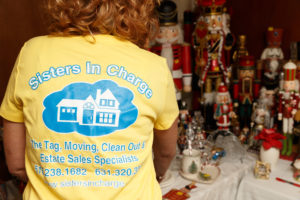
Estate sale know-how
In a recent edition of Country Living magazine, author Caroline Collins McKenzie offered up an estate sale cheat sheet to help customers score the best vintage finds for their home.
Sisters in Charge, the estate sale arm of our company, offers expert guidance in sorting through people’s accumulations, and turning unwanted items into new-found money for homeowners and new-found treasures for you.
Collins McKenzie says there are five timeless finds and valuable antiques shoppers should always be on the lookout for, and, if need be, restore. They include:
Wingback Chairs
According to homethingspast.com, wingback chairs or fireside chairs were designed for enjoying the warmth of a fire while your back and sides were protected from chilly drafts. By the early 1700s, the chairs features cabriole legs and curving lines that set off the beautiful upholstery.

Demilune Tables
The Romans were the first to create a large, semicircular table, but smaller and more elegant versions began appearing in French entry halls in the 1700s, OneKingsLane.com. By the 1750s, the newly dubbed Demilune table was everywhere.

Settees
The Settee, or sofa, was an upholstered seat with back and arms (sometimes upholstered), designed to accommodate two or more people in a sitting or reclining position, according to brittanica.com. The earliest surviving types, dating back to the 17th century in Europe, have sides that let down for conversion into a bed.

Dough Bowls
In colonial America, wooden dough bowls were a warm place where bread could rise prior to baking. A good dough bowl was handed down through generations with each descendant adding her own mark to the history written in wood until she left her dough bowl to her children.

Silver
Silverware is the generically used term to describe our eating utensils – knives, spoons, forks – and also serving dishes and decorative items.
Since the Romans, silver has been used to make utensils, but only royalty or the very wealthy could afford it until the end of the nineteenth century. Indeed, the ability to own and control precious metals has always been the prerogative of nobility and the wealthy merchant classes, writes encyclopedia.com. In the eighteenth century, silver eating utensils and serving pieces were popular in Europe and America for those who could afford them. Gorham Manufacturing Company began making table silver in the U.S. in 1831.

For more information on our upcoming estate sales, go to sistersincharge.com/upcoming-sales/.






Leave A Comment